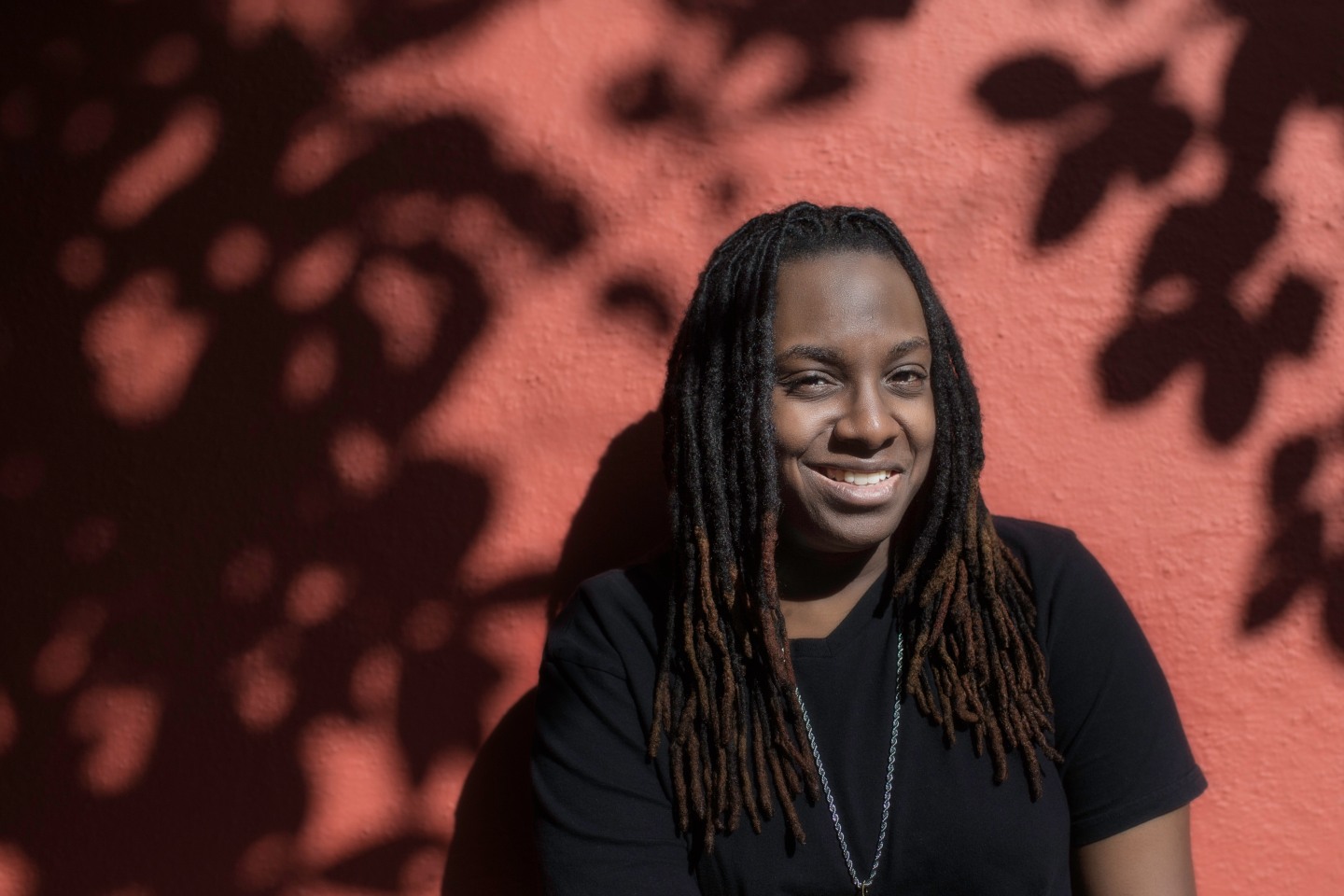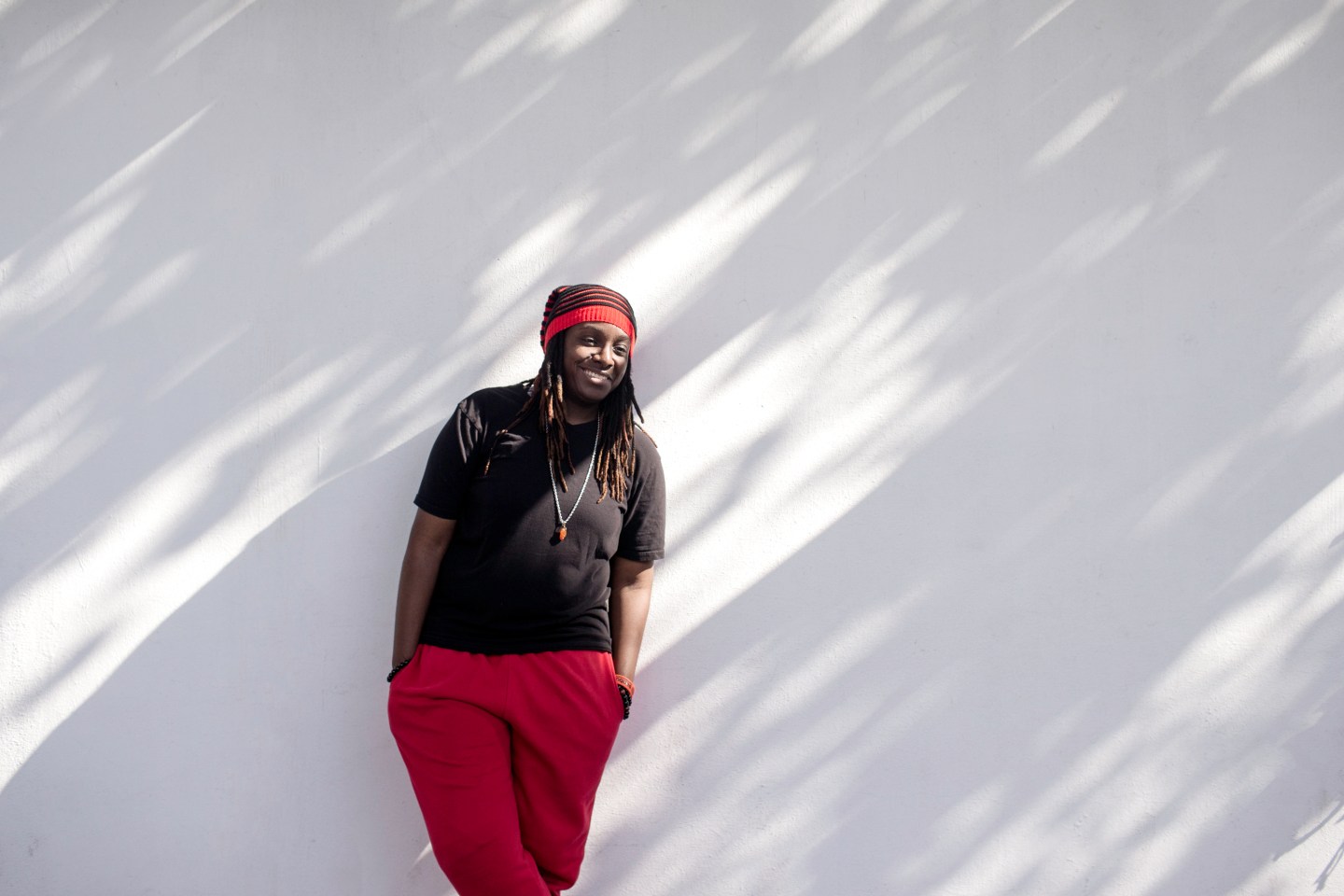For Jlin, The Only Way Is Up
The Indiana artist kickstarted her career with footwork mutations, and her new album Black Origami stretches her sound to another new level.
 Jlin
Photo by Mahdumita Nandi
Jlin
Photo by Mahdumita Nandi
A blank sheet of paper can call forth infinite possibilities to anyone undeterred by its seeming emptiness. And no art form confronts that emptiness with more innovation than origami, which pushes creators to imagine the paper’s potential future form and pursue it through a series of calculated folds. It’s the embodiment of the phrase “work with what you’ve got,” and it’s a concept that Indiana-based producer Jlin translates into music on her new album, Black Origami.
Black Origami features a kind of innovation the artist, born Jerrilynn Patton, has come to be known for. Never one to rely too heavily on melodic samples, Jlin instead explores the movement and meaning to be found amongst volatile beat patterns and otherworldly fragmented sounds. And while her February 2017 EP, Dark Lotus, offered a glimpse into her evolution as a producer, this latest full-length showcases Jlin’s talent for manipulating silence as well as sounds. Tracks like “Holy Child” and “Nandi” convey spirituality through complexity, their rhythms shifting and morphing as elements like drum beats, bells, and stray vocal samples fold into each other with mathematical precision. Other tracks, like “Hatshepsut” and the album’s closer “Challenge (To Be Continued),” layer disparate elements — like whistles and percussion samples from Africa, Japan, India, and HBCU drum lines — to evoke a sort of power that is at once unencumbered, but controlled.
A protege of footwork pioneers RP Boo and the late DJ Rashad, Jlin has spent the years since her 2011 debut track “Erotic Heat” confronting and defying the definitions of the genre to create her own signature sound. When she released her debut album Dark Energy in 2015, Patton was still working at a steel mill in Gary, Indiana, her hometown. But now, having left that day job over a year ago, she’s been able to devote more attention to her craft than ever before. Black Origami feels especially meticulous as a result and her artistic voice is as distinct as ever, even on collaborative tracks with producer Holly Herndon and minimalist legend William Basinski.
When I get Jlin on the phone from her home in Indiana and ask her how her day has been, she responds with one word, but says it as three: “Cha. O. Tic.” She’s been hard at work organizing an important upcoming show. And though she’s looking forward to her work day’s end, she radiates energy and I can hear her talking through a smile. And who can blame her? Still ahead of her in 2017 are a number of performances with creative partner, muse, and dancer Avril Stormy Unger. Plus, she is composing music for Wayne McGregor’s ballet autobiography, set to premiere in London this fall. It will be the first ballet she’s ever attended.
Over the course of our hour-long call, Jlin spoke about what it was like to make Black Origami, the importance of nothingness, and why elephants are her favorite animals. Read on below while listening to the worldwide premiere of "Challenge (To Be Continued)."
Can you walk me through the timeline of making Black Origami?
I started making Black Origami — probably I didn’t even realize I was making [it] at the time — maybe about May-ish, June-ish of 2015. “Nandi” was first. And after making “Nandi,” I noticed this sparseness that I had never had in any other track that I had ever made. It made me go, Oh my god, how deep can this go?
With Dark Energy, even though it was very new to everyone else at the time, I was very over it. I loved it and I still do. It’s just that I had so much time already doing it and I wanted something new — digging for something new, desperately looking for something new.
And so after “Nandi,” I created this track “Black Origami” and it again sounded like nothing I had ever created before. And so I just kept digging until I was like, I think I’m onto something.
Around that time I met Avril [Stormy Unger]. She introduced herself to me saying she had really liked my album Dark Energy. And we built a really good friendship over social media. I happened to go to her page one day and I saw videos of her dancing. And I was like, Oh my god, this is it. Her rhythm and movement was matching my rhythm and sound. And so I made this track that’s completely inspired by her movement, and that was “Carbon 7.” Then after came “Enigma” and “Hatshepsut.” I wanted to definitely honor Hatshepsut, who was a queen out of Egypt.
“1%” was next to the last track. That came about [by] me and Holly [Herndon] just being our normal goofy selves randomly. I was in Berlin shooting for this Native Instruments video that had just been released recently with me and Avril. I had gone to Holly’s house; we had been talking about collaborating for my album for quite some time. I was just like," Hey, time is kind of winding down deadline-wise for me to have the album done and I would like to move along with this." And she’s like, "Oh yeah, of course, of course." And so right before I left her house when I was in Berlin, she’s like, "Yo, I’m gonna send you those stems!" And I’m like, "OK!" And she’s like, "OK!" And that’s kind of how it came up. That’s just the way me and Holly are. Everything is kind of on the fly with us, but always becomes something very solid. You can always count on it because she is as intricately detailed as I am. She is so meticulous about her sounds, just like me.
How did you know the album was complete?
Well, it speaks to me. When an album or song is complete, it is a complete feeling. And that comes with experience and a lot of failing over time. And still failing. It’s just a constant growth, but it’s trusting yourself. You have moments where you definitely doubt yourself, but I know when something is complete; it’s just a feeling.
You said after putting out Dark Energy you were already looking forward. So now that Black Origami is nearly out, how are you feeling about it?
Very happy. I feel very complete, because [on] this one every track is my baby. Even the collaboration tracks. And what I mean by that is, I nurtured those tracks like they were my kids. Not saying that I didn’t do it for Dark Energy, but Dark Energy happened to be [when] I was immature. I think with this album, you can hear not only the contrast between Dark Energy and Black Origami, but you can also hear the growth as well.
 Photo by Mahdumita Nandi
Photo by Mahdumita Nandi
“I love having to create from nothing. When it sounds completely impossible or there’s one of those how-the-hell-am-I-gonna-do-this moments, I think those are my best creative moments.”
I love how when you made the first track and you saw that it was something you had never done, you just kept pursuing that. But if you ever become unsure, how do you push past those feelings?
Sometimes when I become unsure, I become very frustrated and I question my whole career at that point. Why am I even doing this? Or, Why am I putting myself through this? But in uncertainty, I think those are my best moments. That’s one of the reasons why I called this Black Origami, because origami is the art of taking a piece of paper and folding it into something so complex and beautiful. But yet it starts off as an absolute blank sheet of paper. And I love that complexity, I love having to dig from nothing. I live on it. Digging from nothing, having to create from nothing. When it sounds completely impossible or there’s one of those how-the-hell-am-I-gonna-do-this moments, I think those are my best creative moments. Because I have to draw on nothing. And that means everything to me.
One thing I saw when I was reading up on you is how your mother helped shape your first track “Erotic Heat.” Did you look to her for her opinion on Black Origami?
The good thing about when my mom gives me her opinion — and I actually mention this in my album credits — is she’s not biased. She doesn’t think it’s good just because I’m her daughter or whatever. So that’s really helpful to me. But with Black Origami, we did what we always do. I finish a track, she comes in, sits on the end of my bed, and she listens to the track once it’s finished. And she always gives me her critique on it, whether it be bad, good, or indifferent.
With this album, there were times when she’d tell me she felt like I was holding back or she wishes I would just let go — like, she knows I can — and just things like that, which are very helpful to me. It’s almost kind of like when a person knows you already and then they hear your sound and then they just want you to just cut loose and go to your full potential.
But yeah — this album, next album, the album after that — she’ll always be that person. And I definitely don’t take it for granted. She’s been absolutely amazing as far as that goes. Just outside of me being a producer, just being her daughter. She’s just always just so supportive, and I’m forever thankful for that.
On the album you evoke sounds from all over the world. Did that have to do with your traveling more since being able to do music full-time?
I have always wanted to do that, even before I was traveling. I love sounds, period. I’m definitely one of those people that believes for sure that every sound belongs somewhere. And there are certain sounds or certain movements that can strike me so deep and it opens up a totally different world for me. And a lot of that just has to do, that’s spontaneity. I told myself if my music had the spontaneity of Eartha Kitt’s movements, I’d be batting 1000.
Can you tell me about one of these moments where a sound opened up a different world for you?
Yes. There was “Kyanite,” the track that this happened on. I was watching two movies. One of them was Curse of the Golden Flower and the other was a scene in House of Flying Daggers where this girl is dancing. She’s blind, and there’s this guy who’s sitting at a table and he’s throwing these stones and she’s surrounded by drums. And he throws the stone and it hits the drum. And she, with the scarf that she’s wearing, has to hit the drum that the stone hit, doing everything by sound, of course. That entire scene inspired “Kyanite” for me. The way she was moving reminded me of bells. And so you’ll hear a lot of that in “Kyanite.”
I know every creative project is kind of a long learning process in itself. What did you learn about your craft or about your style while making this album?
I learned in doing this — even though I kind of knew this about myself already — that I am never satisfied. I always feel like, if I got it to this point it can be better, even if I love it. I love “Holy Child,” that is probably my favorite track. That and “1%.” OK, “Challenge,” too. So those three tracks, I love them to death. Or to life. But the thing about it is, I know I can do even better than that. I know I can go deeper than that. I love stretching my potential because I don’t believe in peaks. I don’t believe in the start, the peak, and then the downward. No, no, no. Once I start from the bottom and I am going up, I will continue to go up. I don’t believe in coming back down. I believe in "keep stretching." So that’s my drive in life, whether it’s music or anything else.
As you grow and as your sound grows, I think it’s also important to rest your ears in the course of the day. I had to learn that because I’m working around the clock all the time, but resting your ears is really important. Even if you just take that five minutes to yourself or five minutes, fifteen minutes, an hour. Take a nap, that’s another thing. If you can take a nap, take them. I swear, naps change lives. Take a nap. OK, that’s it.
You said “Holy Child” was one of your favorite tracks. Can you tell me about how it came to be?
Even though it doesn’t say it on the album, that track is actually dedicated to DJ Rashad who passed away in 2014. Me and Rashad, we didn’t talk much. But when we did, it was always a teaching moment and him being so informative. Rashad was the person that I would go to and say, “Hey, bro, what do you think about this?” Rashad is the person who actually helped me set up my music equipment and told me what and what not to do when I first started making music from the very beginning. So I really valued what he said.
Rashad was a really good guy, very nice. And so when he passed, it was quite a blow to me and so many people, of course. So I made a dedication track to him, and that’s what “Holy Child” is. “Holy Child” was probably also one of the most challenging tracks that I have ever done because the rhythm changes on that track are quite something, even in the mixing process. There’s a sudden change of rhythm and pace. But I was very just happy that it came out the way that it did.
Lastly, can you tell me about the cover art?
Yes, I love elephants. I. Love. Elephants. Elephants are the most precious thing to me on this planet. So, I asked my label when we designed the cover art [that] I wanted an origami of an elephant. And they sure enough, I don’t know how they did it, they delivered. So there we go.
Have you ever met an elephant?
No, but I really plan on doing so. If I had had enough time I would’ve done it for this album, but definitely on the next one, I want to make a track that is based on how people will go and get an elephant and break the elephant’s spirit to get it to obey. I want to make a track that is completely going against that because I don’t think any animal belongs in a cage, in all respect, but more so an elephant. They’re just beautiful creatures, just this magnificent work of creation. There’s something about them that is just so special to me. I can’t really pinpoint it, but I feel very close to elephants.
Planet Mu will release Jlin's new album, Black Origami, on May 19. Preorder it here.
